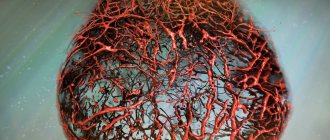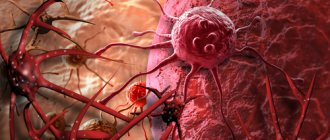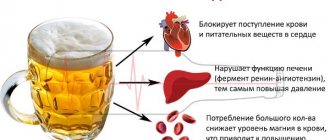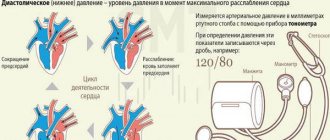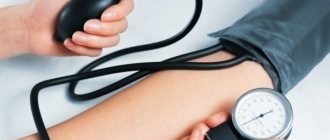What is the danger of arterial hypertension
Arterial hypertension is a dangerous disease, since regular pressure surges lead to the development of serious pathologies. First of all, disorders affect the functioning of the cardiovascular system. These are the main human organs that coordinate all the work of the body. Another danger of hypertension is the effect on related target organs: kidneys, brain, eyes, liver.
Electrocardiogram is one of the main diagnostic methods
Hypertension may be asymptomatic, but high blood pressure affects quality of life. In the absence of timely treatment, complex pathologies may develop that lead to serious consequences:
- hypertensive crisis;
- acute cerebral circulatory disorder;
- heart attack;
- dysfunction of target organs.
With a regular increase in pressure, which is accompanied by severe headaches, there is a high probability of hemorrhage in the cerebral body. If visual function is impaired, the risk of hemorrhage in the eyes and retinal detachment increases.
If kidney function is impaired due to high blood pressure, severe kidney failure may develop.
This is only a part of the possible deviations that arterial hypertension leads to, so timely consultation with a doctor if you have high blood pressure is part of a successful cure and the opportunity to return to a full life without loss.
Hypertension impairs quality of life
How to understand if you have hypertension
Headache
Headache is the main symptom of hypertension. The most characteristic sign of hypertension is a headache in the back of the head, as well as in the temples with a sensation of beating in them.
At the same time, they can be either aching or encircling in nature. If headaches accompany you every day, this is arterial hypertension.
The source of pain in this case is narrowing blood vessels in the brain. An attack of pain usually begins at night or in the morning.
Pain in the back of the head does not always indicate hypertension. This symptom may be a sign of various neurological disorders and spinal diseases. Only a neurologist can accurately identify the cause of a headache. Don't put off visiting your doctor.
When to see a doctor and get tested
A one-time increase in blood pressure will not be a reason to see a doctor if it is provoked by external factors: stress, physical fatigue, lack of sleep, alcohol intoxication. The pressure returns to normal without outside help as soon as the effect of the provocateur ends. In this case, a visit to a specialist is not necessary and diagnostics will be unnecessary.
Diagnosis of hypertension is required in the following cases:
- high blood pressure persists for several days, the levels do not drop even after a full night’s sleep;
- against the background of high blood pressure, pain in the head, vomiting, dizziness, and other symptomatic manifestations of the disease appear;
- high blood pressure is not the only symptom that causes concern; swelling of the limbs and other parts of the body has appeared;
- cases of nasal hemorrhage have become more frequent;
- With high blood pressure, black dots flash before my eyes and I have tinnitus.
If several alarming signs appear, it is recommended to visit a doctor and tell him about the frequency of symptoms and increased blood pressure. The specialist will prescribe a set of measures to carry out diagnostics and establish an anamnesis.
If symptoms of hypertension appear once, a visit to a specialist is not necessary, but it is recommended to monitor your blood pressure and general condition. If pressure surges occur regularly, you should go to a specialist.
If increased blood pressure is accompanied by any of the above symptoms, you should consult a doctor.
Diagnostics in the doctor's office
A mercury sphygmomanometer with a stethoscope allows you to accurately measure blood pressure. But it is rarely used in modern medicine, as it is very large in size and poses a potential threat to the environment.
Inflatable or lever-type aneroid devices, as well as automatic devices, are more often found in the doctor's office. Pressure monitoring can be carried out using devices that measure its level throughout the day.
Aneroid sphygmomanometer
The rules for measuring blood pressure in a doctor's office are the same as for home monitoring. Besides:
- the cuff should be filled 30 mmHg above the point where pulsation disappears;
- pressure should not decrease faster than 2 mmHg per second;
- when measuring, the phase of disappearance of the pulsation should be taken into account, and not the phase of muffling;
- the doctor must take at least two measurements, separated by an interval of a couple of minutes;
- repeated monitoring should be carried out at the same time of day;
Based on measurements taken by the patient at home and in the doctor's office, the doctor can draw conclusions and prescribe treatment. If necessary, he prescribes additional examination.
When receiving medications, you must record your last dose.
Algorithm for carrying out diagnostic measures
Diagnosis of arterial hypertension is carried out in several stages. This is a whole range of measures aimed at studying the functioning of the heart, blood vessels, brain, and kidneys. After a comprehensive examination, the doctor makes a diagnosis and draws up a treatment plan. Therapy is always tailored individually, including medication and recommendations for lifestyle correction.
To make a diagnosis, two or three laboratory tests may be enough, but sometimes diagnostic measures can take a long time, since hypertension does not manifest itself clearly or it is difficult to determine the root cause of the disease.
History taking
Before diagnosing arterial hypertension syndrome, the doctor collects all information about the patient. This makes it possible to determine the required diagnostic studies as accurately as possible.
Basic data that will help a specialist draw up an adjusted diagnostic scheme for hypertension:
- presence of hypertension in the patient’s family;
- date of first recorded signs of hypertension;
- frequency of pressure increase;
- degree of increase in arterial parameters;
- medications taken;
- symptoms accompanying high blood pressure: headaches, vestibular disorders, vomiting, decreased libido;
- working and living conditions of the patient: the influence of stress, physical activity, lack of sleep, mental fatigue;
- diet;
- bad habits;
- heart rhythm disturbances;
- weather dependence.
For women, the doctor will additionally learn about the menstrual cycle, taking oral contraceptive pills, and hormonal medications.
Diagnosis is carried out taking into account the patient’s age, gender, and body characteristics.
It is important to understand the causes of high blood pressure
Diagnosis: hypertension
Let’s say that at a regular medical examination a person finds out that his blood pressure is 150/95 mmHg. Art. Does this mean that the doctor will diagnose him with “arterial hypertension” (or, simply put, hypertension)? Of course not. After just one measurement, such a diagnosis is not made, except, of course, in cases where the readings are too high (for example, above 170/105 mm).
In addition, related factors must be taken into account. For example, if a person was nervous before measuring blood pressure, or even just drank a cup of coffee and smoked a cigarette, his blood pressure will certainly increase. Even the very fact of having your blood pressure measured by a doctor can be a little stressful and cause a temporary increase in blood pressure! This is the so-called “white coat hypertension”.
But if you measure your blood pressure at home, and it stays at 140/90 or higher for several days in a row, this is a serious reason to visit a doctor. And please do not hesitate to go to the clinic, even if you have no other complaints. Any qualified doctor knows that treatment for hypertension must begin at the earliest stage, so he will only praise you for your vigilance!
To clarify the diagnosis, it will be necessary to take a repeated pressure measurement after some time, or even a series of measurements. If the pressure is at least 2-3 times beyond the upper limit of normal (140/90 mm Hg), the diagnosis of hypertension is confirmed. But before starting treatment, it is necessary to establish the cause of hypertension.
After all, increased blood pressure can be the result of some disease or even a side effect of certain medications! In this case, they talk about secondary hypertension, effective treatment of which is possible only if the root cause is eliminated.
Most often, the cause of high blood pressure is various kidney diseases: infections, chronic nephritis and pyelonephritis, kidney stones, adrenal tumors and some other diseases. The kidneys regulate water-salt metabolism in the body. If their work is disrupted, the volume of fluid in the body increases, including, of course, the volume of blood. Remember the example of a pump and tanks, and you will understand that the result is an increase in pressure.
The same thing happens when the blood supply to the kidneys decreases due to narrowing of the renal arteries (this is renovascular hypertension). As a result, the “self-rescue” mechanism is activated: in order to get the necessary nutrition, the kidneys begin to produce a special enzyme (renin), which causes an increase in pressure. Renovascular hypertension is rare, affecting older people or young children and smokers.
Endocrine diseases can also cause hypertension. For example, hypothyroidism or hyperthyroidism (decrease or increase in thyroid hormone levels). Some neurological diseases can also become the root cause of hypertension: increased intracranial pressure, encephalitis, brain tumor.
Particular attention is paid to increased blood pressure in pregnant women. For example, hypertension can develop in the last three months of pregnancy. This is the so-called “late toxicosis” - preeclampsia or eclampsia. High blood pressure can be dangerous for both mother and child, so even with blood pressure above 135/85, appropriate treatment is prescribed.
In addition, medications can increase blood pressure: for example, hormonal contraceptives, appetite suppressant pills (ephedrine, phenylephrine), some anti-inflammatory drugs (indomethacin, voltaren, ortofen, etc.), cortisone and other steroids, glucocorticoids (pre-nisolone, dexamethasone and etc.). Even glyceric acid, which is part of caramel, nicotine and caffeine (including in coffee, Coca-Cola, chocolate) can increase blood pressure.
In order to find the possible root cause of hypertension, special studies are carried out.
For example, to rule out a kidney infection, a urine test (for protein and glucose) is required. A blood test is also required (for hemoglobin, sugar, and sometimes cholesterol). An electrocardiogram (ECG) is also prescribed, and other studies are additionally performed if necessary. If the root cause is identified, the doctor will prescribe appropriate treatment. When the disease that caused hypertension is cured, the blood pressure returns to normal.
Young people (under 30 years of age) with a persistent increase in blood pressure are examined especially carefully - they most often develop secondary hypertension. In the “malignant” course of hypertension, when the disease develops rapidly, the pressure rapidly increases, additional research also needs to be carried out. In this case, there is usually very high diastolic (lower) pressure (more than 120 mm Hg) and pronounced vascular changes. The result is circulatory disorders, changes in blood properties and improper functioning of all organs and systems. With malignant hypertension, kidney failure quickly manifests itself, vision decreases, and the person rapidly loses weight.
If the cause of the increase in pressure is not found (and this happens most often - in 90% of cases!), they speak of primary or essential hypertension. This means that no one knows the exact cause of the development of hypertension! Only provoking factors are known: hormonal imbalance (for example, increased action of the “stress hormone” adrenaline on the heart), metabolic disorders and ion exchange in tissues, dysfunction of the nervous system, atherosclerosis.
Typically, hypertension develops slowly (this is a “benign” course) and gradually passes through three stages. So far there are no changes in internal organs and systems, and the pressure rarely rises, not higher than 160/100 mm Hg. Art. and normalizes on its own during rest, they speak of mild hypertension. This is the first stage of hypertension.
At the second stage, blood pressure rises more frequently (up to 180/110), and it is reduced mainly with special medications. This stage is characterized by exacerbations - hypertensive crises. In addition, changes begin in the cardiovascular system, for example, the left ventricle of the heart enlarges. This is moderate hypertension.
At the third stage, in addition to stable high blood pressure (more than 180/110), various complications of hypertension appear: heart failure, cerebrovascular accident, and sometimes renal failure. The blood pressure can no longer normalize on its own. This is severe hypertension.
In older people, a special type of isolated systolic hypertension sometimes occurs, when at a normal level of diastolic (lower) pressure, systolic (upper) pressure increases: more than 140/less than 90 mm Hg. Art. Despite the low blood pressure levels, this type of hypertension is very dangerous: it is one of the most important risk factors for the development of strokes and heart failure.
A typical representative of a hypertensive patient is my neighbor in the country, Viktor Vladimirovich. Even when he was undergoing a commission at the military registration and enlistment office, he learned about his tendency to increase blood pressure. This is understandable: he has a hereditary predisposition. Mother, sister, aunt - all suffer from hypertension.
In his youth, Viktor Vladimirovich went in for sports, was a healthy man and a real handsome man. But when the everyday worries of work and family life piled up, he abandoned sports. In addition, the work is sedentary, and at home a loving wife prepares abundant delicious dinners. And by the age of 45, Viktor Vladimirovich acquired a solid tummy, and in addition to it, hypertension. I began to “feel” the weather and react to stress with a persistent increase in blood pressure. However, serious increases rarely happened, so Viktor Vladimirovich did not go to the doctor and did not accept any treatment other than rest.
But after a few years I still had to be examined. When Viktor Vladimirovich came to me for a headache pill and complained of frequent headaches, weakness in the morning, constant fatigue, irritability, I immediately suggested that he measure his blood pressure. The result is 150/95 mmHg. Art. Of course, I sent him to the doctor, who diagnosed him with stage 1 hypertension. The doctor prescribed pills to lower blood pressure, and I recommended healing herbal infusions. Within a few months, Viktor Vladimirovich’s blood pressure was completely normalized: it never rose above 135/85.
But here it is summer again, vacation. My neighbors with their whole family left for Crimea. Of course, the treatment was forgotten. And why bother getting treatment if everything is fine? I feel great, my blood pressure is normal! However, the vacation, alas, quickly ended, and everyday work began with the same worries and stress. Headaches, fatigue, irritability began to set in again, and my heart began to ache. For some reason, Viktor Vladimirovich did not remember about the treatment. And here is the result
first hypertensive crisis.
Now the doctor is talking about stage 2 hypertension. But my neighbor, taught by bitter experience, no longer forgets about treatment. And most importantly, he begins to gradually introduce a healthy lifestyle. He “infected” Nadya, his wife, with running: now the two of them run in the nearest park every evening, in any weather. So I am calm for them: they will be able to escape from any disease!
Physical examination
Physical examination includes a complete examination of the patient with measurement of blood pressure, temperature, and skin assessment. During the examination, the specialist palpates the thyroid gland, measures the boundaries of the heart muscle, and examines the vessels that are released through the skin.
Signs of the development of arterial hypertension that can be identified by visual examination:
- heart murmurs;
- rapid or rare pulse;
- cardiac hypertrophy;
- swelling;
- arrhythmia.
What additional diagnostic procedures does a hypertensive patient need to undergo?
After receiving all the results of laboratory tests, the specialist conducts an additional examination, which may consist of the following procedures:
- daily blood pressure monitoring;
- fundus examination;
- aortography;
- echocardiography;
- ultrasonography;
- physical diagnosis;
- Magnetic resonance imaging;
- electrocardiography.
Blood pressure measurement and daily monitoring
Methods for diagnosing arterial hypertension necessarily include measuring blood pressure. It is important for the doctor to monitor the dynamics of jumps in indicators. To create a dynamic scheme, daily pressure monitoring is carried out. If necessary, the spread can be a week, a month or another time period.
If the pressure deviates from the norm by several points with a frequency of several days, longer monitoring is required, stretched over two to four weeks. If the patient is in poor condition, monitoring is carried out in the hospital with special equipment. If the patient's condition is stable, monitoring can be carried out on an outpatient basis.
When self-monitoring your blood pressure, you must follow your doctor's precise instructions. The readings are recorded in a separate notebook. The accuracy of diagnosis and further therapy depend on the correctness of monitoring.
How to diagnose?
The following examinations allow diagnosing hypertension.
Blood pressure measurement
This is the easiest way to detect hypertension. At home, it is recommended to use an electric tonometer , since it is easy to use and does not require additional skills from the patient.
A normal blood pressure is considered to be approximately 120/80 mmHg. Hypertension is typical for a person whose blood pressure is consistently above 140/90.
Measuring blood pressure using an electronic tonometer is easy:
- unfold the equipment;
- put on a special sleeve after measuring your blood pressure and undergoing a series of examinations. on the arm above the elbow or on the wrist, depending on the type of tonometer;
- turn on the device;
- wait for the results displayed on the electronic panel.
Pressure measurement should take place under normal human conditions - comfortable temperature, absence of irritants, calm breathing.
We invite you to watch a video on how to measure blood pressure correctly:
ABPM
ABPM stands for 24-hour blood pressure monitoring method . The procedure is carried out under the supervision of a specialist. The device is attached to the patient’s belt and a cuff is attached to the shoulder.
At certain intervals, the cuff is inflated, and the device records the pressure. Daytime measurements occur every 10-15 minutes, at night - every 30 minutes.
We invite you to watch a video about the ABPM method:
Examination in the clinic
A therapist or cardiologist examines patients with hypertension . A whole range of necessary procedures is carried out aimed at identifying possible diseases associated with vascular tone, blood pressure and the heart:
- ECG.
- Ultrasound of the heart.
- Doppler ultrasound and duplex scanning of the main arteries of the head.
- ABPM.
- General and biochemical blood and urine tests.
If necessary, the doctor will prescribe treatment.
Taking tests
The following biochemical indicators can help diagnose hypertension and determine the risks of cardiovascular complications:
- hematocrit;
- hemoglobin;
- calcium;
- potassium;
- sodium;
- glucose;
- total cholesterol;
- blood lipid spectrum;
- liver transaminases and bilirubin;
- creatinine;
- urea.
Based on the results of diagnosing hypertension, the functional state of internal organs is assessed.
Target organ examination
Diagnosis of hypertension involves assessing the condition of the organs that are primarily affected by the disease. The main “targets” for high blood pressure are :
- Heart . Its function can be checked with ECG, echocardiography and physical examination. With hypertension, its rhythm is disrupted, causing a person to experience significant discomfort, blood vessels narrow, and the heart increases in size.
- Ocular fundus. To determine pathological changes, the ophthalmologist examines the fundus of the eye. There are three stages of eye dysfunction in hypertension:
- on the first, the veins of the retina dilate and the arteries noticeably narrow;
- on the second, microaneurysms appear;
- in the third, the optic nerve suffers, which leads to deterioration of vision.
- The kidneys and adrenal glands are assessed using ultrasound. With increased pressure in the kidneys, the nephrons that filter the blood from toxins die. In the later stages of hypertension, kidney failure often develops.
Lab tests
Laboratory diagnosis of hypertension necessarily includes taking tests:
- general blood analysis;
- blood chemistry;
- blood test for glucose;
- general urine analysis;
- hemostasiogram;
- lipid profile.
Laboratory tests help determine the condition of vital organs and vital systems. Based on deviations in test results, a specialist judges the degree of violations in a particular structure.
To diagnose the patient, tests are prescribed
Electrocardiogram of the heart
Diagnostics determines the condition of the heart muscle. An electrocardiogram is prescribed for the study. Diagnostics is carried out with a special device that measures the frequency of heart contractions, detects noises or other disturbances in muscle function, and records the degree of development of abnormalities. Using an ECG, you can determine the development of pathological processes, identify thickening of vascular walls, and an increase in the size of the heart. A cardiologist deciphers the information. He also makes the initial diagnosis.
Differential diagnosis of target organs
High blood pressure affects internal organs, so differential diagnosis of arterial hypertension is a mandatory procedure. It includes:
- fundus examination;
- ultrasound examination of the kidneys;
- Dopplerography;
- Ultrasound examination of the thyroid gland.
If the differential diagnosis does not provide a complete clinical picture, the specialist additionally prescribes an ultrasound scan of the adrenal glands, urine biochemistry, and writes a referral to other subspecialists.
Diagnostic techniques are needed for an accurate diagnosis. The list of diagnostic measures depends on age, development of lesions, severity of symptoms, gender and other factors. To draw up a correct treatment regimen, a comprehensive diagnosis is required, otherwise the doctor may make a mistake in making a diagnosis.
Impact of diagnostics on the result
The main impact of research and examinations is that only they give a chance to establish the primary source of pathology. The patient suffering from the disease is warned about the difficulty of diagnosis. In fact, only in 20% of cases are specialists able to identify the provocateurs of the disease. If you look at the disease from a professional point of view, almost every external factor can provoke it. Hypertension is becoming alarmingly “younger”, increasing medical statistics. Modern man is under attack from several provocateurs:
- sedentary lifestyle;
- heavy physical labor;
- constant nervous moral tension;
- poor environmental conditions;
- low-quality food products.
Even each individual factor can become a health killer. But to these reasons are added inevitable chronic diseases, especially vegetative-vascular dystonia and osteochondrosis. Careful diagnosis is necessary: doctors “separate” one disease from another, consider the complications of each and identify the true source. That is why the patient must be patient to undergo examinations. This is the only way to get blood pressure lowering drugs through adequate treatment.


